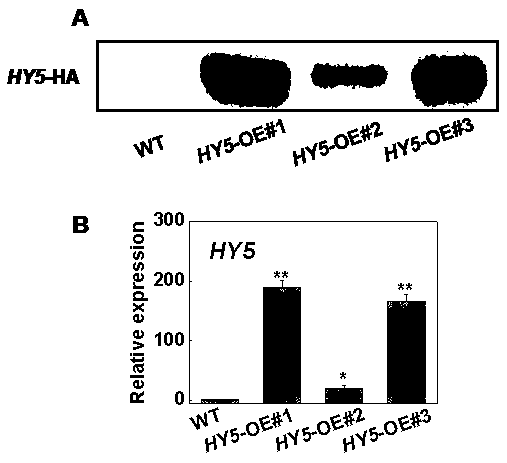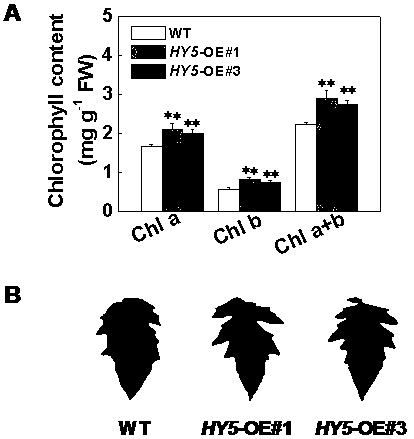Gene for improving chlorophyll synthesis and photosynthesis efficiency of tomatoes and application
A photosynthetic efficiency and chlorophyll technology, which is applied in the fields of molecular biology, physiology, and genetic engineering, can solve the problems of the influence and regulation mechanism of tomato chlorophyll synthesis and photosynthetic efficiency, and has not yet been reported, and achieves the effect of good application value.
- Summary
- Abstract
- Description
- Claims
- Application Information
AI Technical Summary
Problems solved by technology
Method used
Image
Examples
Embodiment 1
[0033] Example 1: HY5 Construction of gene overexpression vector
[0034] In order to clarify the regulation mechanism of light signal on chlorophyll synthesis in tomato plants, the total RNA of tomato leaves was extracted and cDNA was obtained by reverse transcription. Using the cDNA as a template, cloned HY5 Gene.
[0035] clone HY5 Specific methods for gene and construction of overexpression vector: According to the sequence analysis of the coding region, design specific primers and add restriction enzyme sites to the primers ( Asc I and Sal I), primers HY5 -OE-F and HY5 The sequences of -OE-R are respectively ttggcgcgcc atgcaagagc aagcgacgag (shown in SEQ ID NO: 3) and acgcgtcgaccttcctccct tcctgtgcac (shown in SEQ ID NO: 4). PCR cloning with PrimerSTAR high-fidelity enzyme (Beijing Tiangen Technology Co., Ltd.) HY5 fragment, and then double-digest the PCR cloned fragment and the pFGC1008-HA vector (obtained from BioVector NTCC China Plasmid Vector Strain Cel...
Embodiment 2
[0056] Example 2: tomato HY5 Construction and detection of overexpression transgenic material
[0057] The overexpression vector pFGC1008::SlHY5-HA was transformed into Agrobacterium EHA105, and the cotyledons of tomato (variety Ailsa Craig: purchased from the World Tomato Genetic Resource Center, http: / / tgrc.ucdavis.edu) were infected by plant tissue culture Technology, callus induction, resistance induction differentiation and rooting culture to obtain tissue culture shoots (Fillatti et al., 1987), T2 generation seeds were tested for chloramphenicol resistance, 3 / 4 were selected for resistance and the remaining 1 / 4 strain without resistance, indicating that the overexpression vector with the target gene was inserted in a single copy form in this strain. These plants were removed and harvested individually. Validation by Western Blot HY5 Overexpression positive transgenic plants (Wang et al., 2015), the results showed that the wild type had no protein band, while the ov...
Embodiment 3
[0058] Example 3: tomato HY5 Detection of Chlorophyll Content and Photosynthetic Efficiency in Transgenic Materials
[0059] Tomato seedling plants were cultivated in an artificial climate chamber, during which the day and night temperature was 25°C / 20°C, the light time was 12h, and the light intensity was 600μmol m -2 the s -1 . When the tomato seedlings grow to five leaves and one heart, detect wild-type tomato seedlings (WT) and the results obtained in Example 2. HY5 Chlorophyll content of gene overexpression lines ( figure 2 ; Zhang et al., 2016), the maximum photochemical efficiency of photosystem Ⅱ (ΦPSII, image 3 A; Zhang et al., 2014; Li et al., 2016b) and photosynthetic rate (Pn, image 3 B; Zhang et al., 2014; Li et al., 2016b), the results showed that compared with wild-type tomato (WT), HY5 Gene overexpression significantly increased the chlorophyll content in tomato leaves ( figure 2 ), at the same time, both ΦPSII and Pn were significantly increased...
PUM
| Property | Measurement | Unit |
|---|---|---|
| molecular weight | aaaaa | aaaaa |
Abstract
Description
Claims
Application Information
 Login to View More
Login to View More - R&D
- Intellectual Property
- Life Sciences
- Materials
- Tech Scout
- Unparalleled Data Quality
- Higher Quality Content
- 60% Fewer Hallucinations
Browse by: Latest US Patents, China's latest patents, Technical Efficacy Thesaurus, Application Domain, Technology Topic, Popular Technical Reports.
© 2025 PatSnap. All rights reserved.Legal|Privacy policy|Modern Slavery Act Transparency Statement|Sitemap|About US| Contact US: help@patsnap.com



